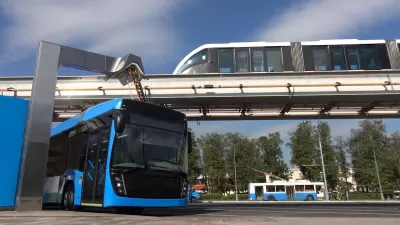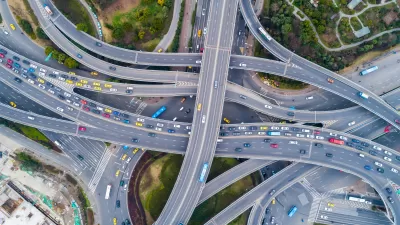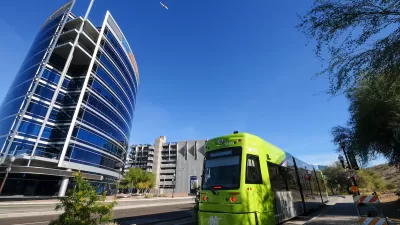Last week I attended the Transportation Research Boards (TRB) 89th annual meeting, which attracted approximately 10,000 transportation professionals from around the globe to Washington DC. More than 2,000 papers were presented at more than 700 sessions, plus several hundred committee meetings took place. Let me share some highlights.
Last week I attended the Transportation Research Boards (TRB) 89th annual meeting, which attracted approximately 10,000 transportation professionals from around the globe to Washington DC. More than 2,000 papers were presented at more than 700 sessions, plus several hundred committee meetings took place. Let me share some highlights.
The most exciting event for me was session 499, titled "Vehicle Miles Traveled Reduction Targets: Will This Strategy Get the Desired Results?" a debate about the benefits, drawbacks, and viability of VMT reduction targets. Professor Patricia L. Mokhtarian and I spoke in favor of such targets, and while Alan E. Pisarski and Samuel Staley spoke against them.
These critics based their opposition to vehicle miles traveled (VMT) reduction targets on the following assumptions:
-
"Transportation" means driving. They assume that walking, cycling and public transportation are inefficient modes which should play a minimal role in a modern transportation system (in a previous debate Staley called them "novely modes").
-
Everybody wants to maximize their vehilce travel, so any effort to reduce VMT is harmful to consumers.
-
Everybody wants to live in a large-lot, automobile-dependent, suburban home.
-
Automobile travel is economically beneficial, so any effort to reduce vehicle travel harms the economy.
These assumptions are outdated. Most transportation professionals I know understand the importance of creating a more diverse and efficient transportation system. They realize that demographic and economic changes (such as aging population, rising future fuel prices, increasing traffic congestion, changing consumer preference, increasing health and environmental concerns) are reducing growth in vehicle travel and increasing demands for alternative modes and more accessible, "smart growth" communities, so it is increasingly important that our current policies and planning practices help create a more diverse and efficient transportation system in the future.
As a test, I asked the audience to raise their hands if they would like to drive more annual miles than they currently do. No hands went up. I then asked, "How many of you would prefer to drive fewer annual miles and rely more on alternative modes, provided you had high quality walking, cycling and public transit options." About a third of the audience raised their hands.
In a previous Planetizen Post I presented research indicating that beyond an optimal level (probably 3,000 to 5,000 annual vehicle-miles per capita), the costs of vehicle travel exceed its economic benefits, and that high rates of VMT associated with reduced per capita economic productivity. As a result, VMT reductions strategies tend to increase efficiency and support economic development.
Critics also argued that VMT reductions are extremely difficult to achieve. For example, they claim that doubling population densities only reduces VMT by 5-10%. Yes, it is true that most individual mobility management and smart growth policies have modest impacts, but their effects are cumulative and synergistic (total impacts are greater than the sum of individual impacts). Smart growth includes increased land use density, mix, street and path connectivity, walkability, transit service quality, and parking management. As a result, people who live and work in smart growth tend to drive 20-40% less than in conventional, automobile-oriented communities, and as a result experience various savings and benefits, including transportation cost savings, accident reductions, improved mobility for non-drivers, and improved fitness and health.
During the debate I discussed results of my study, Socially Optimal Transport Prices and Markets which describes the requirements of an efficient and equitable transportation system (consumer options, cost-based pricing, neutral public policies), identifies existing transport market and planning distortions, and estimates the change in travel activity that would result if these were corrected. This research indicates that with more efficient markets consumers would choose to drive significantly less, rely more on alternative modes, choose more accessible locations, and be better off overall as a result.
The critics argued that, although such reforms are justified, they should simply be implemented, with vehicle travel reductions as an outcome rather than resulting from targets. Yes, ideally citizens and public officials would understand the merits of transportation policy reforms and would implement them, but I pointed out that in practice there is considerable resistance to change, and our current transport policies and planning practices are often contradictory; most communities are making some efforts to improve transport options, encourage use of alternative modes and support smart growth development while still expanding highways, applying inefficient pricing, requiring generous parking supply, and restricting multi-family, infill development. VMT reduction targets allow individual short-term planning decisions to be consistent with long-term, strategic goals. For more information see my report, "Are Vehicle Travel Reduction Targets Justified?"
I was pleased to see that sustainability was often mentioned at the TRB Annual Meeting, but was disappointed that it was generally apply simply to climate change. Although climate change is an important sustainability issue, true sustainability is much more. It refers to balancing economic, social and environmental objectives. Climate change emission strategies would not be truly sustainable if they were inequitable, spoiled the economy, or imposed other types of environmental harms. True sustainability requires that we identify and implement the climate change emission reduction strategies which also achieve other planning objectives, such as congestion reduction, road and parking cost savings, consumer savings and affordability, improved mobility for non-drivers, accident reduction, sprawl reduction, and improved public fitness and health. I'm sure that this issue will recieve considerable discussion in future years.
Another issue that is (finally) receiving serious attention is vehicle parking. Parking has tremendous costs (many vehicles are worth less than the parking space they occupy, and the total value of parking facilities is probably much larger than the total value of roadways), and parking supply and pricing have tremendous effects on travel behavior and land use, so this subject is important for researchers and practitioners. Below are examples of some parking-related papers:
"Minimum Parking Requirements, Transit Proximity, and Development in New York City" (10-1644)
"Station Area Planning and Parking Management in the Urban Core: Cases in Oakland and Berkeley" (10-3279)
"Carsharing Parking Policy: Review of North American Practices and San Francisco Bay Area Case Study" (10-2921)
"Carsharing and Reduced Vehicle Ownership: Making the Connection in Residential Parking Requirements" (10-0232)
"Comparison of Parking Requirements in Zoning and Form-Based Codes" (10-2818)
"Impacts of Minimum Parking Requirements" (P10-1316)
"How Parking Standards Can Be Applied More Flexibly" (P10-1317)
"Parking Standards Within the Fairfax County Transportation Demand Management Parking Study" (P10-1318)
"Parking Standards: An International Perspective" (P10-1319)

Planetizen Federal Action Tracker
A weekly monitor of how Trump’s orders and actions are impacting planners and planning in America.

Map: Where Senate Republicans Want to Sell Your Public Lands
For public land advocates, the Senate Republicans’ proposal to sell millions of acres of public land in the West is “the biggest fight of their careers.”

Restaurant Patios Were a Pandemic Win — Why Were They so Hard to Keep?
Social distancing requirements and changes in travel patterns prompted cities to pilot new uses for street and sidewalk space. Then it got complicated.

Platform Pilsner: Vancouver Transit Agency Releases... a Beer?
TransLink will receive a portion of every sale of the four-pack.

Toronto Weighs Cheaper Transit, Parking Hikes for Major Events
Special event rates would take effect during large festivals, sports games and concerts to ‘discourage driving, manage congestion and free up space for transit.”

Berlin to Consider Car-Free Zone Larger Than Manhattan
The area bound by the 22-mile Ringbahn would still allow 12 uses of a private automobile per year per person, and several other exemptions.
Urban Design for Planners 1: Software Tools
This six-course series explores essential urban design concepts using open source software and equips planners with the tools they need to participate fully in the urban design process.
Planning for Universal Design
Learn the tools for implementing Universal Design in planning regulations.
Heyer Gruel & Associates PA
JM Goldson LLC
Custer County Colorado
City of Camden Redevelopment Agency
City of Astoria
Transportation Research & Education Center (TREC) at Portland State University
Camden Redevelopment Agency
City of Claremont
Municipality of Princeton (NJ)






























